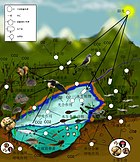景观流行病学
(重定向自景觀流行病學)
景观流行病学是研究疾病与环境因素之间的关系的科学。类似景观生态学,[1] 景观流行病学经由分析风险模型和环境风险因素,来控制疾病的传播。[2]
历史[编辑]
1996年,叶甫根尼·帕夫洛夫斯基提出了微观上的病原体由环境系统整体决定的理论。[3] 随着地理资讯系统和遥感等技术的发展,以及景观生态学的完善,景观流行病学已经可以应用在研究许多疾病(例如疟疾、汉坦病毒、莱姆病和恰加斯氏病)上。[4]
参考文献[编辑]
- ^ Kitron, U. "Landscape Ecology and Epidemiology of Vector-Borne Diseases: Tools for Spatial Analysis." Journal of Medical Entomology. 1998(35):435-445.
- ^ Pavlovsky, E.N. Natural Nidality of Transmissible Diseases, With Special Reference to the Landscape Epidemiology of Zooanthroponse. Urbana, Ill.: University of Illinois Press, 1966.
- ^ Galuzo, I.G. "Landscape Epidemiology (epizootiology)." Advances in Veterinary Science & Comparative Medicine. 1975(19):73-96.
- ^ Brownstein, J.S.; Rosen, H.; Purdy, D.; Miller, J.; Merlino, M.; Mostashari, F.; Fish, D. "Spatial Analysis of West Nile Virus: Rapid Risk Assessment of an Introduced Vector-Borne Zoonosis." Vector Borne and Zoonotic Diseases. 2(3):157-164.
| ||||||||||||||||||||||||||||||||||||||||||||||||||||||||||||||||||||||||||||||||||||||||||||||||||||||


